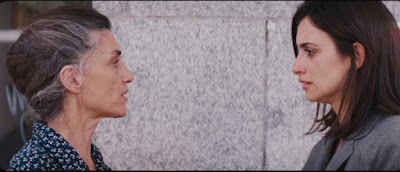It is sad there are plays disappearing from the repertoire of the major theatres who are now putting on new tick-box State Of The Nation plays or Woke-To-Caffeine-Level revivals with gender bounced characters in drab modern dress using hand-mikes. Where are revivials of particularly 20th Century European dramas to be found - the ones not that well-known enough to become a West End star vehicle for a GAME OF THRONES actor.
Step forward the National Theatre, all the more surprising as it has become The National Theatre of The Crashingly Obvious under Rufus Norris' PC Worldview. But here we are back in 1956 in the strange, blackly comedic world of Friedrich Dürrenmatt for his most famous play THE VISIT. Dürrenmatt was a Swiss writer whose novels and plays did much to elevate German drama in post WWII.
THE VISIT is a deadly cocktail of the harsh judgemental world of Brecht peopled with the conniving, small-minded citizens from the plays of Oden von Horváth while shot through with Dürrenmatt's own satire. It has proved his most successful play in English language versions including the sanitized 1964 film with Ingrid Bergman and Anthony Quinn, but was also the basis for an opera as well as the last Broadway musical of John Kander and the late Fred Ebb starring Chita Rivera and Roger Rees (his last show before his death).
Jeremy Herrin's production of Tony Kushner's US-based adaptation takes up the whole of the Olivier's stage and makes much use of the under-stage drum to make whole new sets appear before us, although it must be said that there is not much joy looking at Vicki Mortimer's drab and murky sets for the depressed town of Slurry in upstate New York.
Slurry is a town in sharp decline: businesses are failing, mainline trains don't stop there anymore and the city government is running out of money. Only one thing can save them and it looks like it might be about to happen - Claire Zachanassian, the world's richest woman, was born in Slurry and she is coming back to visit. Although she left as a young girl under scandalous circumstances, the mayor begs her former lover Alfred Ill to put the city's case to the eccentric widow.

The imperious and glamorous Claire arrives and soon has the whole town at her feet - although she reveals there's not just a monetary change in her life as she now has two false legs and a false hand! Alfred discovers this while asking her for the (ahem) hand-out for the city. Claire says she is willing to help the town on one condition which she will reveal at that night's gala reception. After a lavish, dull homecoming ceremony with child athletes and a huge choir, Claire announces she will give the town one billion dollars - half for the town's coffers, half to be divided between Slurry's families.
After the ecstatic applause dies down, Claire reveals her condition: Alfred was her lover when she was young and after she became pregnant, he disowned her. She tried to bring a paternity suit but the trial judge and Alfred fixed the hearing by introducing two male witnesses who purjured her and the case was dismissed forcing her to leave the town in shame. Now the trial judge is Claire's butler and her two clownish courtiers are revealed to be the two witnesses whom she tracked down to blind and castrate. Now she wants her final revenge on Slurry: one billion dollars - if Alfred is killed.

And that's about it - the following two acts tread water for the inevitable to happen, the second act is purgatorial as it is the same scene replayed again and again as Albert begs his community not to kill him while also noticing that all his neighbours now own credit cards and are spending out on the expected windfall. Albert tries to escape but the town turn out at the station to stop him getting the train.
The third act is a strange mix of tension and obviousness as Albert's fate is revealed when the town make their decision, watched dispassionately by Claire. It is no surprise that it was adapted into an opera; it's basic plotline would be well suited to the medium. Like Brecht, Dürrenmatt does nothing to make Alfred sympathetic so - because she has the best lines - I was totally behind Claire to triumph. It makes for a very lop-sided battle of wills.
None of Dürrenmatt's characters have anything that equals depth so well done to Sara Kestelman and Nicholas Woodeson for bringing vigour to their roles of the disenchanted school head teacher and Slurry's garrulous Mayor. Hugo Weaving brings increasing levels of unbelieving panic to his role of shopkeeper Albert Ill as one by one, his friends and family choose Claire's promised money rather his safety, it was good to see him on stage after having only ever seen him on screen before.
The ice-cold heart of the show is the wonderful Lesley Manville who delivers every killer put-down with a soured thud; in her hands the improbable Claire becomes a very human-sized avenger. It was a measure of her performance that - rather than the usual replication of Scutari hospital on a wet Wednesday night - the audience was silently attentive and, during her denunciation of Slurry and Alfred, you could hear a pin drop. Seemingly modelled on elements of Madonna, Lauren Bacall and Elaine Stritch, it's Lesley Manville's show.
An evening of revenge and retribution which I would recommend although Tony Kushner really does like crossing his t's and dotting his i's... I would suggest having a foyer bar break for the dull second act.

















































